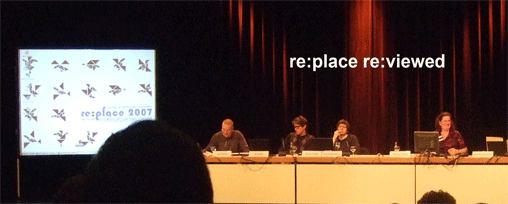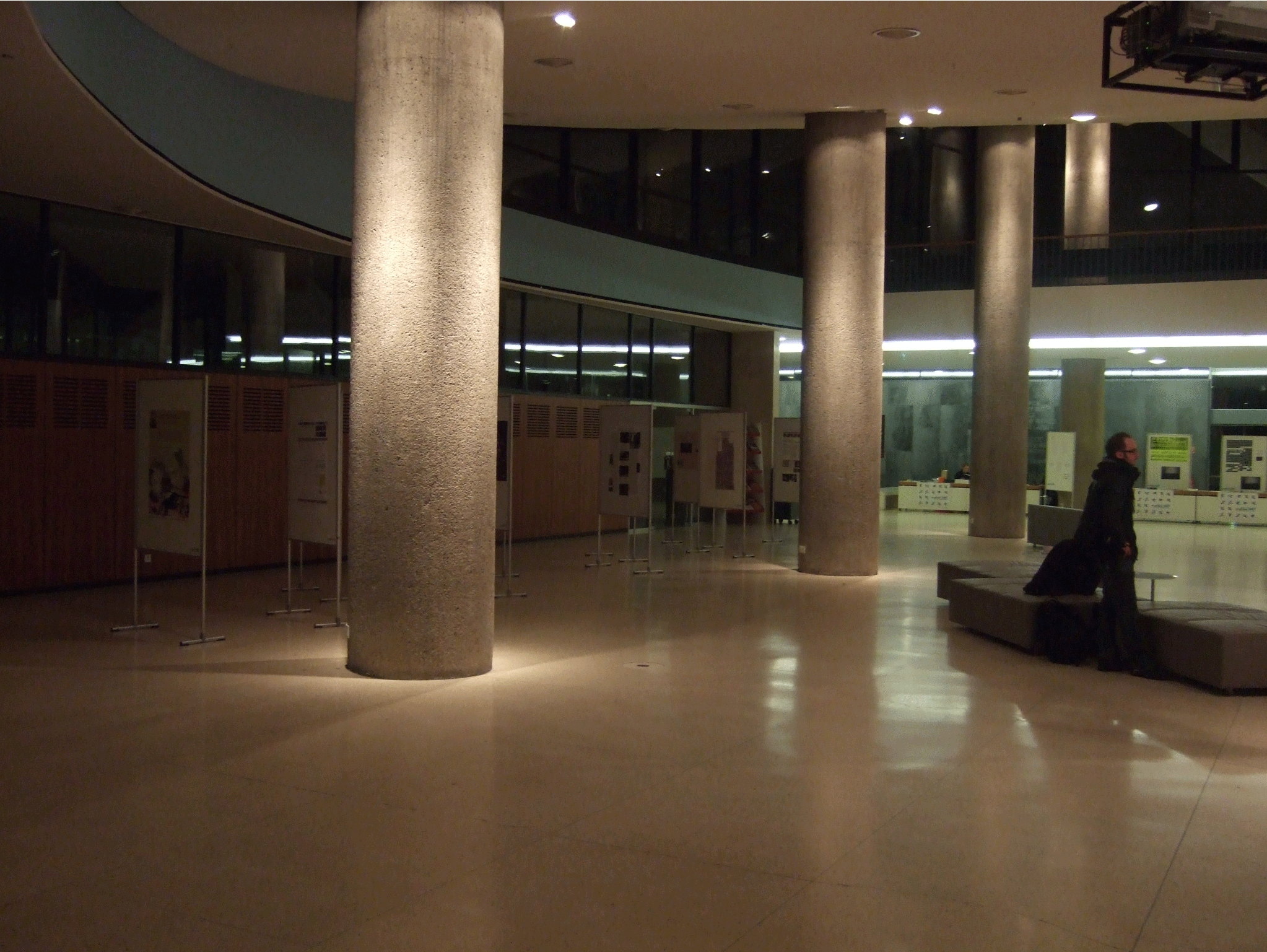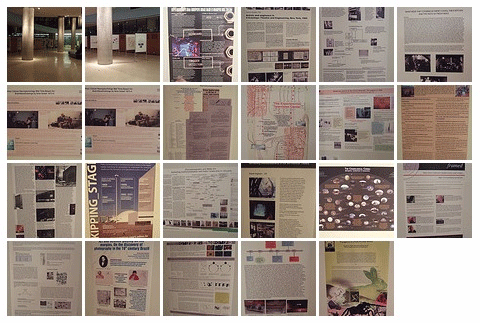
re:place collectively re:viewed
by: Jon CATES
(US), Winnie FU (HK), Mary HAMMER (US), Rachelle Viader KNOWLES (CA),
Eleni MICHAILIDI (GR), Reginald NJEMANZE (NG), Nicolas ROMANACCI (DE),
Joanna WALEWSKA; PL), Nina WENHART (AT), and Rolf WOLFENSBERGER (CH)
re:place 2007 was the second international conference on the histories
of Media, Art, Science and Technology. It took place in Berlin from the
15th until the 18th of November 2007 at the Haus der Kulturen der Welt.
re:place followed the first conference Refresh!, the First International
Conference on the Histories of Media Art, Science and Technology held
at the Banff New Media Institute, Canada, in 2005 (cf. Oliver Grau ed.,
MediaArtHistories, MIT 2007). In the second conference, re:place was chaired
by Andreas Broeckmann and Gunalan Nadarajan supported by an advisory board
and a program committee with many well-known key players of the field
Media Art Histories. The conference consisted of several pre- and post-conference
activities, which were only partly open to the public, and many parallel
events. The three-day conference itself was organized into ten thematic
panels, evening key lectures, lunchtime lectures and poster sessions.
The conference was also complemented by three independently organized
exhibitions that were shown in Berlin at the same time: 9 Evenings Reconsidered:
Art, Theatre and Engineering at the TESLA, From Spark to Pixel at the
Martin-Gropius-Bau and History Will Repeat Itself at the KW. The combination
of conference proceedings, parallel events and exhibitions, gave conference
attendees many choices to engage in a wide range of activities during
re:place.
In the introductory talk Oliver Grau gave an overview of the development
of the field of MediaArtHistories before and after Refresh! and asked
what value can research in this field achieve within the framework of
Image Science and Digital Humanities? Starting with the mission of the
conference series (www.mediaarthistory.org) the presentation created a
"discipline strategic" bridge opening up a perspective to overcome
the often placement of Media Arts in a ghetto. In support of that Grau
showed the increasing significance of new scientific instruments for the
field, *collective* online image and text archives, like www.virtualart.at,
www.mediaarthistory.org, which document the art and theory production
of the last decades. He finished with a note of caution regarding the
too strong particularization in this area and made a plea for a concerted
policy and strategy for collectively documenting, archiving and collecting
the art of the latest history.
In his opening remarks, Andres Broeckmann referred specifically to the
comma between "Media" and "Art" in the subtitle of
the conference. He repeated this comment later while introducing the speakers
of Panel 5 (which he moderated). Broeckmann stated the organizers gave
a great deal of consideration to this distinction while organizing the
conference and that it is indicatory of their approach. Unfortunately,
as a result, Media Art Histories were less thoroughly addressed as a field.
In Broeckmann's explanation, most of the panelists came from very diverse
fields. Panels were arranged around special topics. This combination of
various fields and approaches in the topical panels would have offered
the opportunity to inform a cross-disciplinary toolset of Media Art Histories
methods and strategies, but this chance went by unused. (See
also: Oliver Grau (Ed.): MediaArtHistories, Cambridge/Mass. (MIT Press)
2007.)
Panels
The 10 panels of re:place covered a variety of subjects and topics with
a few themes connecting multiple panels and presentations. Longer panel
reviews follow this general review of re:place.
Panel 1
was on the topic of ART, SCIENCE AND ENGINEERING as sites/places where
early experiments in Media Art took place, most often as a combined form
of research and development, focusing on examples of their intersections.
The panel was moderated by Edward Shanken, with panelists Michael Century,
Stephen Jones, Eva Moraga and Robin Oppenheimer and is reviewed by Nina
Wenhart.
The 2nd panel,
INTERSECTIONS OF MEDIA AND BIOLOGY, incorporated speakers from vastly
different study or artistic backgrounds and study epochs. The first two
speakers, Assimina Kaniari and Jussi Parikka, adopted a historical approach
on understanding the relationship between Biology and Media Art, while
the last two attempted to incorporate theories into their respective art
works with Michele Barker describing how the Life Sciences interact with
Digital culture and Boo Chapple experimented with sound in relation with
biological systems. This panel was moderated Ingeborg Reichle and is reviewed
by Winnie Fu.
In Panel 3,
HISTORIES OF ABSTRACTION, the four lecturers offered brilliant and sophisticated
studies on seemingly quite different subjects. Laura Marks, Arianna Borrelli,
Amir Alexander and Paul Thomas offered complex and diverse perspectives
with highly specialized and elaborated insights that are detailed in the
review by Nicolas Romanacci.
Panel 4,
The COMPARATIVE HISTORIES OF ART INSTITUTIONS, was moderated by Stephan
Kovats and included presentations by Lioudmila Voropai, Renata Sukaityte,
Christoph Klütsch and Catherine Hamel. This panel raised questions
of the possibilities of institutional critiques and is reviewed by jonCates.
Panel 5
traced some of the Media Art Histories that can be told in a local context,
namely in Australia, Poland, Japan and the North American Pacific Coast.
This panel, PLACE STUDIES: MEDIA ART HISTORIES, raising the complex issue
of how national and local processes relate to broader national and international
media art contexts. Eleni Michailidi reviews this panel, discussing how,
as Media Art's global networks have had an acute impact on the development
of local artistic and critical practices, analyzing their interactions
and mutual influences can help us understand the different ways in which
Media Art develops. With: Daniel Palmer, Ryszard W. Kluszczynski, Caroline
Seck Langill, Machiko Kusahara.
The panelists of Panel 6, MEDIA THEORY IN PRACTICE, charted intersections of Media theory
and practice through points of tension and friction, conflicts between
innovation and institutional frameworks, displacements, immateriality
and the instability of memory in all its forms. This panel included Kathryn
Farley, Nils Röller, Wendy Hui Kyong Chun, Antony Hudek and Antonia
Wunderlich as panelists and is reviewed by Rachelle Viader Knowles.
IINTERDISCIPLINARY THEORY IN PRACTICE, the 7th Panel, started by a brief introduction of the speakers by
the Moderator Sara Diamonds. She buttressed the effort made by the speakers
to apply the emerging forms of Interdisciplinary Theories to Practice,
not only in Media Art History but across various domains of knowledge.
The papers presented by Christopher Salter, Simone Osthoff, Janine Marchassault
and Michael Daroch painted pictures of a hybridized knowledge of Meta
Analysis of Methodology and the various points of Productive Collision;
not only to New Theories but as they relate to New Practices. Panel 7
is reviewed by Reginald Njemanze.
All lectures of Panel 8, PLACE STUDIES: RUSSIA / SOVIET UNION, as well as an introduction
by Inke Arns (who tried to outline the importance of Russian avant-garde
movements and its technology related utopias) clarified the background
of New Media Art in Central and East Europe. In Joanna Walewska's review
of Panel 8, she discusses the panel's attempt to extrapolate the future
meaning of collaboration between artists and engineers from the histories
of such collaborations. With: Olga Goriunova, Margareta Tillberg, Margareta
Voehringer, and Irina Aristarkhova.
Panel 9, CROSS
CULTURAL PERSPECTIVES, investigated the interrelationships and differences
between Western and non-Western views. The moderator, Bernd Scherer, stated
that this investigation involves a great deal of exchange between cultures,
and that the results may challenge the current definitions of modernity.
Each panelist, including Erkki Huhtamo, Cynthia Ward, Manosh Chowdhury
and Sheila Petty, presented a paper that attempted to challenge the traditional
Western view and encourage exchange between cultures. The Cross Cultural
Perspectives panel is reviewed by Mary Hammer.
The final panel, CYBERNETIC HISTORIES OF ARTISITC PRACTICES, was introduced
and moderated by Geoff Cox. The connections between cybernetics and artistic
or, more precisely, emergent everyday practices was presented in two computer-archaeological
case studies by David Link and Kristoffer Gansing. Both speakers were
separately looking at different occurrences in the early software/hardware
history when engineers and programmers were experimenting with the cybernetic
machines to produce something other than what they were originally designed
for. Brian Reffin Smith then delivered the literally final speech of the
panels in a kind of conference performance. In his review of Panel 10, Rolf Wolfensberger, describes how Brian Reffin Smith passionately
denounced the ongoing mystification of the computer by artists, scientists
and art-critics alike since the early 1970ies and the progressive culture
of the spectacle fed by the capitalistic IT-industries since the mid 1990ies.
Poster Presentation
In addition to the panels, re:place also hosted a Poster Presentation
of about 20 projects, reaching from doctorial projects about individual
artists such as Lenka Dolanova's poster on her research into the Vasulkas
or Darko Fritz's research on Vladimir Bonacic to a poster from and about
The Experimental Television Center. If time is limited, posters are a
way of at least including projects in the context of the conference. But
the way in which the posters were physically presented at re:place was
very impolite. The posters were put on simple stand, quite small and too
close to one another. Still, the worst aspect of the presentation of the
posters was their location. The posters stood in the last corner of the
entrance hall, a place with no sufficient lighting. In addition there
were two poster presentations, where everyone had 5 minutes to present
their projects. Even if time is limited, there can be better ways of showing
and presenting these posters, if the organizers are really interested
in enriching the content of the conference.

the re:place posters (in the dark, on the very left)

Links
to all the posters can be found here: http://www.flickr.com/photos/ninawenhart/sets/72157603265770404/
Key Note
The most pointed approach to describe the framework of a potential field
of media art histories was formulated, performed and put into a flaming
manifesto by Siegried Zielinski. He made a claim for being enthusiastic,
something which was missing in a lot of presentations. Zielinski's Key
Note speech
Critique & Conclusion
The notion of 'place' in the title of the conference was not as evident
as the premise of the conference seemed to promise. Perhaps the proposed
"thematic focus on located-ness and the migration of knowledge and
knowledge production in the interdisciplinary contexts of art, historiography,
science and technology" was by definition too vague. Glimpses of
local practices at the fringes of mainstream reception (such as the Eastern
European Media Art Histories thread that connected a few panels and panelists)
or inspirations taken from crossing borders and boundaries did come up
momentarily during several of the panels, but practically none of the
panelists or moderators made a specific reference to the title of the
conference or used this theme to 'locate' her presentation in a broader
context. Some of the panels left the impression of a more or less artificially
conceived theme with a collection of presentations. This impression seemed
to render the hope of the moderators for controversial discussions almost
futile from the start. Seen in retrospect the conference did not fully
re:cover its 'place' although many of the presentations, posters and discussions
as such were fascinating without doubt.
Links
- re:place 2007 at Haus der Kulturen der Welt: http://www.mediaarthistory.org
- 9 Evenings Reconsidered at TESLA: http://www.fondation-langlois.org/html/e/page.php?NumPage=2092
- History Will Repeat Itself at the KW: http://www.kw-berlin.de/deutsch/program_frameset.htm
- From Spark to Pixel at the Martin-Gropius-Bau: http://tinyurl.com/3asg88